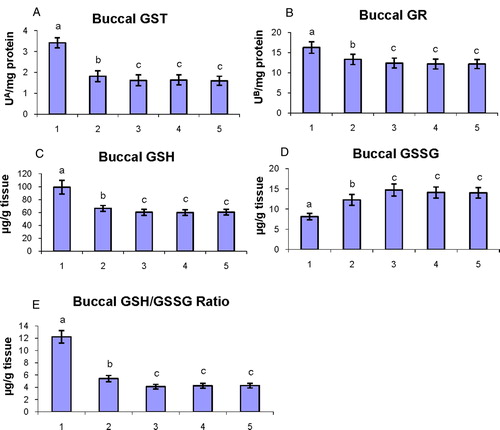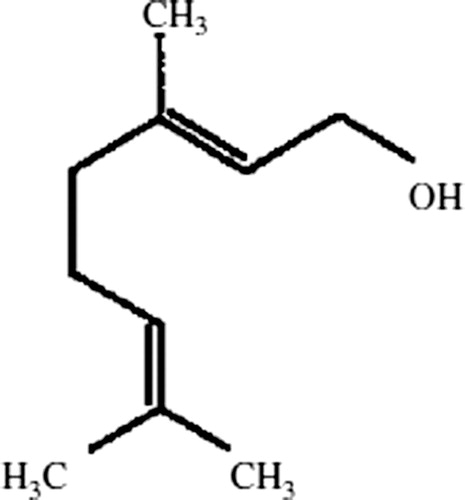Figures & data
Figure 2. (A) Gross appearance of oral squamous cell carcinoma (indicated by arrow) in DMBA-alone-painted hamsters. (B–F) Histopathological changes in the buccal mucosa of control and experimental hamsters in each group (hematoxylin and eosin, ×400). (B) Well-differentiated squamous cell carcinoma exhibiting epithelial and keratin pearls in DMBA-alone-treated group 1 hamsters. (C) Buccal pouch epithelium from group 2 hamsters (DMBA + geraniol) exhibiting moderate keratosis and hyperplasia. (D–F) Buccal pouch epithelium from group 3 (geraniol alone 250 mg/kg b.w.), group 4 (liquid paraffin + corn oil), and group 5 (untreated control) hamsters showed normal cellular architecture with no signs of cell proliferation.
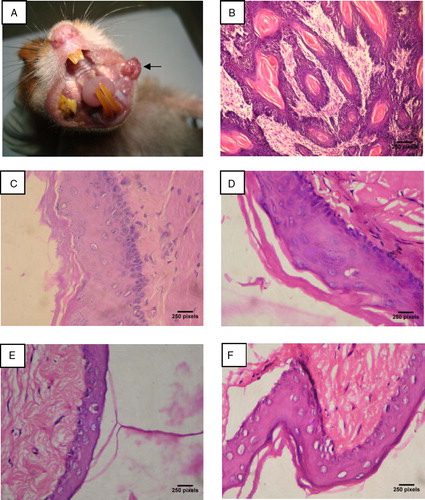
Table 1. Tumor incidence, tumor number, tumor volume, and tumor burden in control and experimental hamsters
Table 2. Histopathological changes in the buccal mucosa of control and experimental hamsters (n = 10/group)
Table 3. The levels of LPO by-products (TBARS, LOOH, and CD) in the plasma and buccal mucosa of control and experimental hamsters
Figure 3. The status of enzymatic antioxidants (GPx, SOD, and CAT) and non-enzymatic antioxidants (vitamin E and GSH) in the plasma of control and experimental hamsters. (1) DMBA, (2) DMBA + geraniol (250 mg/kg b.w.), (3) Geraniol alone (250 mg/kg b.w.), (4) Corn oil + liquid paraffin, (5) Control. Bars are mean ± SD for 10 hamsters in each group. a–cValues that do not share a common superscript letter (a, b, and c) in the same column differ significantly at P < 0.05 (DMRT). UA – micromoles of glutathione utilized/minute; UB – the amount of enzymes required to inhibit 50% nitroblue-tetrazolium (NBT) reduction; UC – micromoles of H2O2 utilized/second.
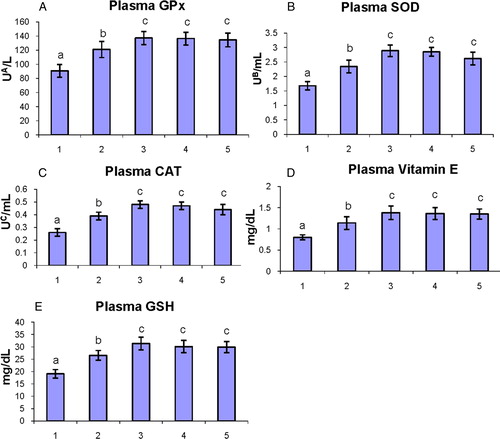
Figure 4. The status of enzymatic antioxidants (GPx, SOD, and CAT) and non-enzymatic antioxidants (vitamin E and GSH) in the buccal mucosa of control and experimental hamsters. (1) DMBA, (2) DMBA + geraniol (250 mg/kg b.w.), (3) Geraniol alone (250 mg/kg b.w.), (4) Corn oil + liquid paraffin, (5) Control. Bars are mean ± SD for 10 hamsters in each group. a–cValues that do not share a common superscript letter (a, b, and c) in the same column differ significantly at P < 0.05 (DMRT). UA – micromoles of glutathione utilized/minute; UB – the amount of enzymes required to inhibit 50% nitroblue-tetrazolium (NBT) reduction; UC – micromoles of H2O2 utilized/second.
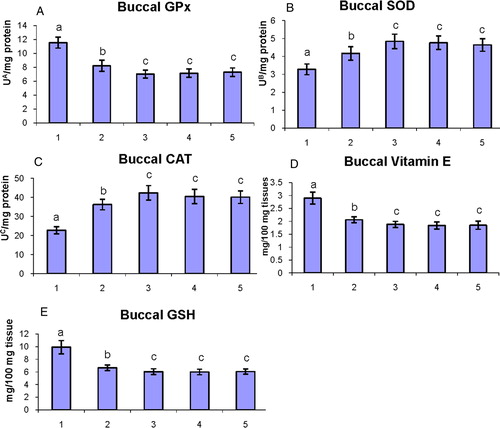
Table 4. Activities of phase I detoxification enzymes in the liver of control and experimental hamsters
Figure 5. The activities of phase II detoxification enzymes (GST, GR, and DTD) and GSH in the liver of control and experimental hamsters. (1) DMBA, (2) DMBA + geraniol (250 mg/kg b.w.), (3) Geraniol alone (250 mg/kg b.w.), (4) Corn oil + liquid paraffin, (5) Control. Bars are mean ± SD for 10 hamsters in each group. a–cValues not sharing a common superscript letter (a, b, and c) in the same column differ significantly at P < 0.05 (DMRT). UA – micromoles of 1-chloro-2,4-dinitrobenzene-reduced glutathione conjugate formed/minute. UB – micromoles of NADPH oxidized/hour. UC – micromoles of 2,6-dichlorolindophenol reduced/minute.
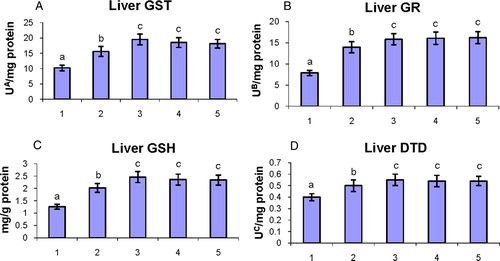
Figure 6. The status of phase II detoxification enzymes (GST and GR) and glutathione content (GSH, GSSG, and GSH/GSSG ratio) in the buccal mucosa of control and experimental hamsters. (1) DMBA, (2) DMBA + geraniol (250 mg/kg b.w.), (3) Geraniol alone (250 mg/kg b.w.), (4) Corn oil + liquid paraffin, (5) Control. Bars are mean ± SD for 10 hamsters in each group. a–cValues not sharing a common superscript letter (a, b, and c) in the same column differ significantly at P < 0.05 (DMRT). UA – micromoles of 1-chloro-2,4-dinitrobenzene-reduced glutathione conjugate formed/minute. UB – micromoles of NADPH oxidized/hour.
